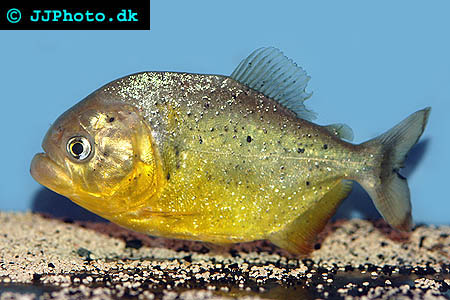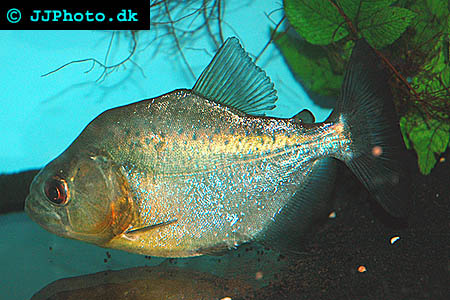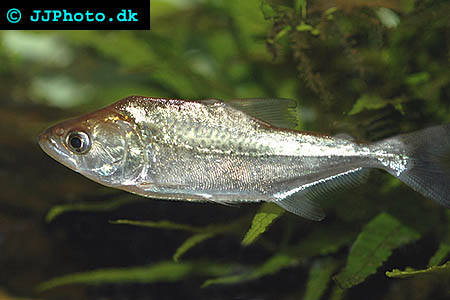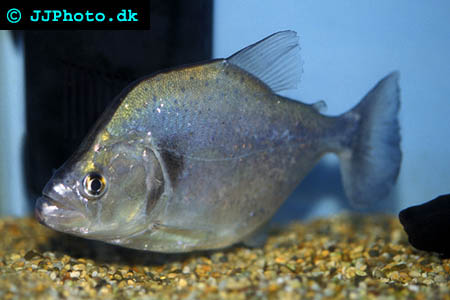Piranhas are carnivorous freshwater species from the subfamily Serrasalminae. There exists many different Piranha species, divided into five genera: Catoprion, Pristobrycon, Pygocentrus, Pygopristis and Serrasalmus. The Piranhas inhabit South American rivers and several species have been successfully kept by aquarists.
Examples of commonly kept Piranha species
Commonly known as Caribe, Cariba, Cariba piranha, Black shoulder piranha, Shoulder spot piranha, Orinoco piranha, Black eared piranha and Venezuelan red belly piranha. Native to Venezuela.
Commonly known as Common piranha, Red piranha, Red bellied piranha, Redbelly piranha and Red breasted piranha. Found in many different parts of the Amazon. Captive bred specimens available.

Piranha of the species Serrasalmus ternetzi. Copyright www.jjphoto.dk
Commonly known as Blacktail piranha, San Francisco Piranha, Piren and “The King of the Piranhas”. Native to the Rio San Francisco region of the Amazon. Hard to obtain and quit expensive. Decorated with a golden streak. Highly aggressive.
Commonly known as Green Piranha, Brandtii piranha and Cavaca. One of the most aggressive Piranha species. Native to the Rio San Francisco region of the Amazon. Sports a golden colouration.
Commonly known as Black Piranha. Feature dark markings and red eye. Not a schooling fish!
The Piranha aquarium
Different Piranhas reach different maximal sizes and it is therefore impossible to say how large a Piranha aquarium should be. You have to research the species you are interested in and find out how large they can become as adults. Generally speaking, you should provide each fish with 15-20 gallons of water. Most Piranhas are schooling fish that should not be kept alone, so quite a big aquarium will be needed. Also keep in mind that it is easier to keep the water quality up in a large aquarium. If you keep a large school, you can decrease the figure somewhat, especially if you have strong filtration and perform frequent water changes.

Piranha of the species Serrasalmus rhombeus. Copyright www.jjphoto.dk
Decorating a Piranha aquarium
When decorating your Piranha aquarium, you should try to create a replica of the River Amazon where these fishes live. Piranhas appreciate drift wood, areas of dense vegetation and open spaces to swim around in. (A strict hierarchy will develop in the aquarium with one of the bigger Piranhas being the leader when they swim around.) You should ideally also install a powerhead that will provide a strong and steady current, since this will make the environment more similar to the River Amazon.
Maintaining a Piranha aquarium
Since Piranhas feed on meaty food and are pretty messy eaters, keeping the water quality up will be one of your most important tasks. Use a combination of mechanical and biological filtration and make sure that the mechanical filters are powerful enough. When buying a mechanical filter, you should get one that can cope with at least 50% more water than what is found in your aquarium. If you have a 200 gallon aquarium, you should get a filter suitable for a 300 gallon aquarium and so on. The River Amazon is acidic and the pH-value in the aquarium should therefore be between 6.5 and 6.9. Piranhas can adapt to conditions up to ph 7.5, but it is not really healthy for them. The water temperature should be high, around 27 degrees C.

Piranha of the species Serrasalmus elongatus. Copyright www.jjphoto.dk
Feeding Piranhas
Piranhas are carnivore and must be give live, fresh or frozen meaty food types in the aquarium. You can for instance give them fish fillets, lean chicken meat, and beef heart without any fat. Prawns can be used to promote vivid coloration.
A few hours after feeding, check your aquarium for any leftovers that may otherwise pollute the water. Piranhas never return to eat rotten meat. In the wild, Piranhas do not necessarily eat every day. You can therefore feed them every second or third day in the aquarium.

Piranha of the species Serrasalmus geryi. Copyright
www.jjphoto.dk



